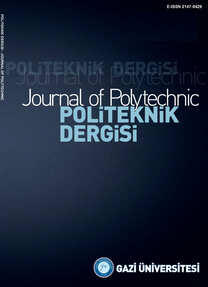R260 Ray Çeliğinin Değişen Sıcaklıklardaki Davranışının EMI Yöntemi ile İncelenmesi
EMI yöntemi, sıcaklık etkisi, ray
Investigation of the R260 Rail Steel Behavior at Varying Temperatures by EMI Method
EMI method, temperature effect, rail,
___
- 1. Aktan A. E., Helmicki A. J. and Hunt V. J., “Issues in health monitoring for intelligent infrastructure”, Smart Materials and Structures, 7(5): 674-692, (1998).
- 2. Doebling S. W., Farrar C. R. and Prime, M. B., “A summary review of vibration-based damage identification methods”, The Shock and Vibration Digest, 30(2): 91-105, (1998).
- 3. Shankar R., “An integrated approach for structural health monitoring”, PhD thesis, Indian Institute of Technology Delhi, (2009).
- 4. Siebel, T. and Lilov, M., “Experimental investigation on improving electromechanical impedance based damage detection by temperature compensation”, Key Engineering Materials, 569: 1132-1139, (2013).
- 5. Baptista F. G., Budoya D. E., De Almeida V. A. and Ulson J. A., “An experimental study on the effect of temperature on piezoelectric sensors for impedance-based structural health monitoring”, Sensors (Basel), 14(1): 1208-1227, (2014).
- 6. Zou, D., Liu, T., Liang, C., Huang, Y., Zhang, F., Du, C., “An experimental investigation on the health monitoring of concrete structures using piezoelectric transducers at various environmental temperatures”, Journal of Intelligent Material Systems and Structures, 26(8): 1028-1034, (2015).
- 7. Wandowski T., Malinowski P. H. and Ostachowicz W. M., 2016, “Delamination detection in CFRP panels using EMI method with temperature compensation, Composite Structures, 151: 99-107, (2016).
- 8. Xu G., Xu B., Xu C. and Luo Y., “Temperature effects in the analysis of electromechanical impedance by using spectral element method”, Multidiscipline Modeling in Materials and Structures, 12(1): 119-132, (2016).
- 9. Haider M. F., Giurgiutiu V., Lin B. and Yu L., “Irreversibility effects in piezoelectric wafer active sensors after exposure to high temperature”, Smart Materials and Structures, 26(9): 095019, (2017).
- 10. Vishay Micro-Measurements, “Strain Gages and Instrumentation Knowledge base”. http://www.vishaypg.com/micro-measurements/stress-analysis-strain-gages/knowledge-base-list/ and http://www.vishaypg.com/micromeasurements/videos/?video513, (2013).
- 11. Giurgiutiu V., “Structural health monitoring with piezoelectric wafer active sensors”, Second Edition, Elsevier, U.S.A., (2014).
- 12. Rabelo, D.S., Steffen, V., Neto, R.M.F. and Lacerda, H.B., “Impedance-based structural health monitoring and statistical method for threshold-level determination applied to 2024-T3 aluminum panels under varying temperature”, Structural Health Monitoring, 16(4), 365-381, (2017).
- 13. Sepehry, N., Shamshirsaz, M. and Bastani, A., “Experimental and theoretical analysis in impedance-based structural health monitoring with varying temperature”, Structural Health Monitoring, 10(6), 573-585, (2010).
- 14. Sepehry, N., Shamshirsaz, M. and Abdollahi, F., “Temperature variation effect compensation in impedance-based structural health monitoring using neural networks”, Journal of Intelligent Material Systems and Structures, 22(17), 1975-1982, (2011).
- ISSN: 1302-0900
- Yayın Aralığı: 6
- Başlangıç: 1998
- Yayıncı: GAZİ ÜNİVERSİTESİ
LPI Based Comparison of Turkey And Mexican Logistics Sector
İsmail HOCAOĞLU, Tayfun UYGUNOĞLU
Denge Kontrol Sisteminin LQR ile Gerçek Zamanlı Durum Geri Beslemeli Kontrolü
Ceren ATİLA DİNÇER, Ali Mert ERDEK, Ayşe KARAKEÇİLİ, Nuray YILDIZ
Odunun Yüzey Pürüzlülüğünün ve Adezyon Direncinin Yapay Sinir Ağları ile Tahmini
A Comparison of Copula Families on Dependence Structure of Extreme Order Statistics
